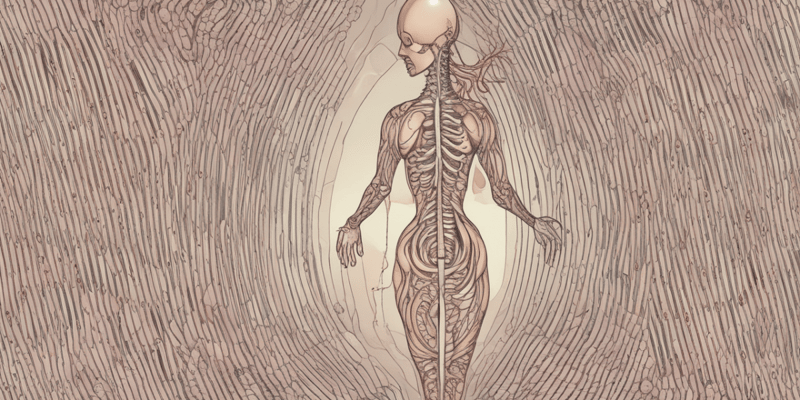36 Questions
What is the primary function of the gonads in the reproductive system?
To produce offspring
Which type of cells in the testes produce androgens such as testosterone?
Interstitial cells
What is the ideal temperature for sperm production in the human body?
34⁰C
What is the function of the cremaster muscle in the scrotum?
To contract and relax the scrotal skin
What is the function of the epididymis in the male reproductive system?
To expel sperm during ejaculation
What is the primary function of the penis in the male reproductive system?
To deliver sperm to the female reproductive tract
What percentage of semen is made up of sperm?
5%
What is the function of fibrinolysin in semen?
Liquefy the semen soon after ejaculation
Which gland produces a thick, clear mucus that neutralizes acidic urine?
Bulbourethral gland
What is the function of prostaglandins in semen?
To stimulate reverse peristalsis of uterine tubes
What is the pH of semen?
Slightly alkaline
What is the approximate duration of the process from a spermatogonia to a full spermatozoa?
64 days
What nutrient is provided to the sperm in semen for ATP synthesis?
Fructose
What is the function of the acrosome in the head of the sperm?
To contain lysozyme for penetration
What is the approximate number of sperm produced per day?
100-300 million
What is the primary function of the midpiece of the sperm?
To produce energy for the sperm
What is the nervous system responsible for controlling ejaculation?
Sympathetic nervous system
What is the result of no sexual arousal in the male sexual response?
Constriction of erectile tissue arterioles
What is the primary function of the scrotum in the male reproductive system?
To regulate the temperature for optimal sperm production
Which structure is responsible for the contraction that expels swimming sperm during sexual stimulation and ejaculation?
Epididymis
What is the term for the 'sperm factories' in the testes?
Seminiferous tubules
Which hormone is produced by the interstitial cells in the testes?
Testosterone
What is the purpose of the dartos muscle in the scrotum?
To wrinkle the scrotal skin
What is the term for the external genitalia in the male reproductive system?
Penis and scrotum
What is the composition of the fluid produced by the seminal vesicles?
Yellowish, viscous fluid
What is the purpose of the clotting factors in semen?
To coagulate the semen after ejaculation
Which part of the male duct system forms the ampulla and joins the duct of the seminal vesicle?
Spermatic cord
What is the main function of the prostate gland in the male reproductive system?
To produce enzymes and citrate
What is the purpose of the relaxin enzyme in semen?
To relax the uterine tubes
What is the pH of the environment in the male urethra and vagina that the semen needs to neutralize?
Acidic
What is the purpose of the round of mitosis during spermatogenesis?
To produce a primary spermatocyte and a feeder cell
What is the role of the sympathetic nervous system in the male sexual response?
Control of ejaculation
What is the function of the lysozyme in the acrosome of the sperm head?
To help the sperm penetrate the egg
What is the result of the meiosis in the primary spermatocyte?
Production of two secondary spermatocytes
What is the role of the parasympathetic nervous system in the male sexual response?
Control of erection
What is the function of the mitochondria in the midpiece of the sperm?
To produce energy for the sperm
Study Notes
Male Reproductive System
- Produces gametes (sperm) and secretes hormones (testosterone)
- Consists of testes, epididymis, ductus deferens, ejaculatory duct, urethra, and accessory glands (seminal vesicles, prostate gland, and bulbourethral glands)
Testes
- Produce sperm through spermatogenesis
- Contain seminiferous tubules ("sperm factories") with spermatogenic cells that give rise to sperm and interstitial cells that produce androgens (testosterone)
Scrotum
- A sac of skin and superficial fascia outside the abdominopelvic cavity that helps maintain a temperature of 34°C, ideal for sperm production
- Muscles: dartos muscle (wrinkles scrotal skin) and cremaster muscle (arises from internal oblique muscles)
Accessory Ducts
- Epididymis: nonmotile, immature sperm leave testis and enter epididymis, where muscles contract to expel swimming sperm during sexual stimulation and ejaculation
- Ductus deferens (vas deferens): runs upward as part of the spermatic cord from the epididymis through the inguinal canal into the pelvic cavity, terminating as the ampulla and joining the duct of the seminal vesicle to form the ejaculatory duct
Male Accessory Sex Glands
- Seminal vesicles: produce yellowish, viscous fluid (60% of semen) containing nutrients, clotting factors, and prostaglandins
- Prostate gland: produces milky-white, slightly acidic fluid containing enzymes and citrate
- Bulbourethral glands: produce thick, clear mucus that neutralizes acidic urine
Semen
- White, milky, and somewhat sticky mixture of sperm (5%), testicular fluid, and accessory gland secretions
- Contains fructose, which provides energy for sperm ATP synthesis
- Chemicals: prostaglandins stimulate reverse peristalsis of uterine tubes, relaxin enhances sperm motility, seminalplasmin is a prostate antibiotic protein, and clotting factors coagulate semen after ejaculation
- Slightly alkaline to neutralize acidic environment in the male urethra and vagina
Spermatogenesis
- Begins at puberty and continues throughout life
- Process from spermatogonia to full spermatozoa takes about 64 days
- Involves mitosis, meiosis, and maturation of spermatids into spermatozoa
Sperm
- Produced at a rate of 100-300 million per day
- Head contains a nucleus and acrosome with lysozyme (enzymes that help penetrate the egg)
- Midpiece contains many mitochondria for energy production
- Tail created by cytoskeleton moves the sperm
Male Sexual Response
- Erection: penile erectile bodies flood with blood due to parasympathetic nervous system stimulation
- Ejaculation: sympathetic nervous system stimulation causes muscle contractions and semen release
Explore the basics of the human reproductive system, including the functions of gonads, hormones, and accessory organs. Learn about the male reproductive system, including the testes, seminiferous tubules, and scrotum.
Make Your Own Quizzes and Flashcards
Convert your notes into interactive study material.
Get started for free



